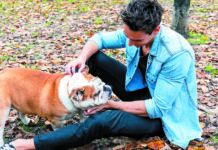More than one in six children and adolescents in the United States — some 13 million kids — are obese, with many more not quite in that category but overweight nonetheless. At the same time, more than 43 million households in this country have pet dogs, many of whom crave more interaction with their human families and, most definitely, more physical activity with them. Hmm….
Researchers at both the Tufts Cummings School of Veterinary Medicine and Tufts University’s Friedman School of Nutrition Science and Policy had the same thought you just did. Might it be possible to help overweight kids reach healthy weight in a fun way that brings their loved dogs into the mix rather than in a way that feels punitive and therefore won’t stick?
Earlier scientific investigations suggest it’s an avenue worth exploring. Consider the results of a Scottish study called Children, Parents and Pets Exercising Together (CPET), which included more than two dozen families with boys and girls who had an average age of just under 11. The researchers reported that those kids assigned to a 10-week dog-based physical activity intervention during which they were encouraged to walk the family pet more frequently and for longer periods of time “enjoyed taking part.” The children even remarked themselves “that it was a way to decrease screen time” while they “bonded more with their dog.” Such results, say the investigators, suggest that “using pet dogs as the agent of lifestyle change in physical activity interventions is both feasible and acceptable” and is therefore a “promising strategy.” They also point to an earlier study of overweight adults taking part in a four-month intervention with their pet dogs that led to significant increases in physical activity concurrent with significant decreases in body weight.
Yet other research suggests that heavier pet owners report a greater sense of attachment to their dogs — not surprising in light of the fact that the same overweight dog owners reported less social support from other people. If that same extra attachment to a pet dog is found to be experienced by overweight children who might be vulnerable to a lack of social support from their peers, then a dog becomes an even more logical means to the end of becoming more physically active and closer to healthy body weight — which in turn could help increase self image and bring a child into a more vibrant social mix.
All of this went into the thinking of Tufts veterinary nutritionist Deborah Linder, DVM, DACVN, when she began brainstorming research of her own to see how ownership of a pet dog might be able to encourage physical activity and healthy weight. “I originally started out wanting to go straight to an intervention where we paired children with their pets and looked at direct results in terms of increased exercise and subsequent weight loss,” she says. “But the field of human-animal interaction is so new — and incorporating pets into childhood wellness is so new — that my colleagues and I felt we needed more background data to see how a study should be designed.” That’s where Boston’s Museum of Science comes in.
Living Laboratory Project
The Museum of Science on the Boston-Cambridge border houses the Charles Hayden Planetarium as well as the Mugar Omni Theater showing nature and history films and almost any day of the week is teeming with visiting children. It is also home to what it calls a Living Laboratory. “The Living Laboratory is a project whereby the museum invites researchers to come and conduct some of their data collection actively with visitors right inside,” Dr. Linder explains. “Right now, the Tufts Institute for Human-Animal Interaction [see box] is working to find out more about relationships between children and their dogs. So we’re taking surveys of visiting children and their parents or legal guardians — getting demographics and family background information. That’s part one.
“Part two will be inviting a couple of dozen families to come and have interviews later this summer and fall. Then instead of just giving a quick survey, we’ll do a more in-depth interview asking about families’ relationships with their pets, for instance, ‘What would be the benefits if you were in a program that got you more interactive with your pet? What would be the challenges?’
“The overarching goal at this point is to gain a great foundation of knowledge,” Dr. Linder says. “Once we are able to tease out a pattern, or patterns, in family-pet dynamics, we’ll be ready to start the actual weight-control intervention. The information we gain now will tell us what the most promising intervention is to try. We don’t really know yet. Is it walking the dog twice a day for 30 minutes a day? That may come up as a possible methodology, and parents and their children could very well answer, ‘That’s not fun.’
“So it’s community-based research. We’ll ask, ‘what would you want to do? What would you not want to do? What would your dog not want to do?’
“We want to make sure our studies have the most benefit possible, and we need to enlist the help of future potential participants to know what’s best,” Dr. Linder says. If people have input into study design, results could be more significant than those of the pilot studies done to date. Maybe the intervention will be for the child to run around a field with a ball or Frisbee and have the dog chase him or her until s/he throws or flings it. Maybe it will be something else.
“We haven’t looked into play,” Dr. Linder says — “play inside the house, outside the house. Maybe the goal is just decreasing screen time — getting a child away from the computer, away from the television.” There certainly have been studies suggesting that people eat more when they sit passively watching TV, with the refrigerator close by.
“I’d also like to look at the altruistic aspect of treating a dog well and see if that could have an impact on activity level,” Dr. Linder notes. “My hope is that kids will want to engage with their dog because it’s fun,” she says. “But it may be important to say that children should play with their dog because they love them, because dogs need attention and should also have the chance to be happy in addition to healthy.”
The actual intervention won’t start till 2016, Dr. Linder says. But if you’ve got an overweight child in the house — or an overweight adult — you don’t need study results to begin a new relationship with your dog that makes life more invigorating for the pet as well as for others in the family. Obviously, you never want playing with a dog to feel like work for a child, insisting that they put in so many minutes a day as if it were an awful chore. But you can start the ball rolling, so to speak, by engaging in more and longer walks with your dog and asking your child to join you to keep you company. You can take the initiative by throwing a ball to the dog in the backyard yourself. If your child sees the dog and you enjoying yourselves in a way that’s new, s/he very well may want in.
You’ve got to tailor the activity to the dog’s needs, too, of course. A toy breed simply is not going to require the level of activity craved by a Lab or other larger, active breed. But even toy dogs need some walking, fetching, and so on.
Dr. Linder points out that based on information she finds in her work, it may turn out that it’s better to have an activity intervention that applies to all children to encourage healthful behaviors with dogs, no matter what the child’s weight status to begin with.




